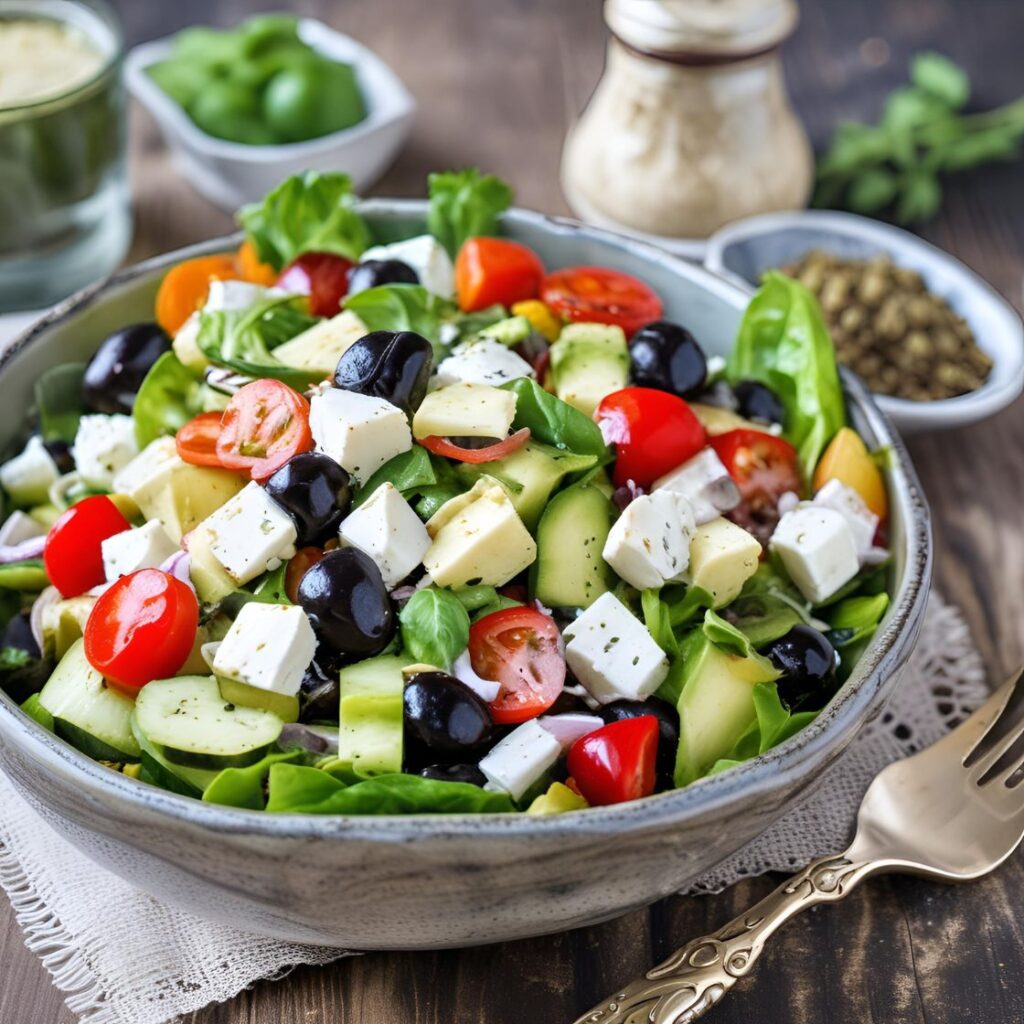Authentic Greek Mediterranean Salad Recipe – Fresh, Healthy & Delicious
Imagine yourself sitting at a taverna overlooking the azure waters of the Aegean Sea, savoring each bite of a perfectly balanced Greek Mediterranean salad. Hm, appetite, right?
This isn’t just another vegetable mix – it’s a celebration of Mediterranean flavors that transforms simple, fresh ingredients into something extraordinary.
The secret lies in selecting peak-season vegetables, quality olive oil, and authentic Greek feta cheese, then combining them with a traditional vinaigrette that brings out each component’s natural character.
I recommend using vine-ripened tomatoes, crisp cucumbers, and genuine Kalamata olives for the most authentic experience.
This salad captures the essence of Greek cuisine – fresh, vibrant, and wonderfully satisfying.
Recipe Overview & Preparation Details
| Detail | Information |
|---|---|
| Prep Time | 15 minutes |
| Cook Time | 0 minutes |
| Total Time | 15 minutes |
| Course | Salad, Side Dish, Light Meal |
| Cuisine | Greek, Mediterranean |
| Servings | 4-6 people |
Fresh Ingredients & Smart Substitutions
| Ingredient | 4 Servings | 6 Servings | 8 Servings | Alternative Options |
|---|---|---|---|---|
| Large tomatoes | 4 medium | 6 medium | 8 medium | Cherry tomatoes (2 cups) |
| Cucumber | 1 large | 1.5 large | 2 large | English cucumber (seedless) |
| Red onion | 1/2 medium | 3/4 medium | 1 medium | Sweet onion, shallots |
| Kalamata olives | 1/2 cup | 3/4 cup | 1 cup | Green olives, mixed olives |
| Feta cheese | 4 oz (113g) | 6 oz (170g) | 8 oz (227g) | Goat cheese, ricotta salata |
| Bell pepper | 1 medium | 1.5 medium | 2 medium | Any color bell pepper |
| Extra virgin olive oil | 1/4 cup | 1/3 cup | 1/2 cup | Avocado oil, good quality vegetable oil |
| Red wine vinegar | 2 tablespoons | 3 tablespoons | 4 tablespoons | White wine vinegar, lemon juice |
| Dried oregano | 1 teaspoon | 1.5 teaspoons | 2 teaspoons | Fresh oregano (1 tablespoon) |
| Garlic cloves | 2 cloves | 3 cloves | 4 cloves | Garlic powder (1/2 teaspoon) |
| Sea salt | 1/2 teaspoon | 3/4 teaspoon | 1 teaspoon | Kosher salt, table salt |
| Black pepper | 1/4 teaspoon | 1/3 teaspoon | 1/2 teaspoon | White pepper, freshly ground |
Essential Kitchen Tools for Perfect Assembly
Creating an authentic Greek Mediterranean salad requires minimal equipment, but the right tools make the difference between a decent salad and an exceptional one.
- A sharp chef’s knife ensures clean cuts that won’t bruise your vegetables, while a large wooden bowl provides the perfect vessel for gentle mixing without damaging delicate feta cheese.
- You’ll also need a reliable cutting board, preferably wooden or bamboo, which won’t dull your knife blade.
- A whisk helps create the perfect emulsion for your dressing, though a fork works in a pinch.
- Consider investing in a good salad spinner to remove excess water from your vegetables, preventing a watery final product.
- A fine-mesh strainer comes in handy for rinsing olives and removing excess brine that could overpower the other flavors.
Step-by-Step Vegetable Preparation
Begin by selecting the ripest tomatoes you can find – they should yield slightly to gentle pressure and have a deep, rich color.

Wash them thoroughly under cool running water, then pat dry with paper towels. Remove the core using a sharp paring knife, making a small circular cut around the stem area. Cut each tomato into wedges, approximately 6-8 pieces per tomato depending on size.
The wedges should be substantial enough to hold their shape but not so large that they become unwieldy.
Place the cut tomatoes in a colander set over a bowl and sprinkle lightly with salt. This draws out excess moisture and concentrates the flavors.
Let them drain for 10-15 minutes while you prepare the other ingredients.
Cucumber Cutting Techniques for Maximum Crunch
Choose firm cucumbers with bright green skin and no soft spots. English cucumbers work particularly well because they have fewer seeds and thinner skin.
Wash the cucumber thoroughly, scrubbing gently to remove any wax coating. You can peel the cucumber completely, leave it unpeeled, or create an attractive striped pattern by peeling every other strip lengthwise.
Cut the cucumber in half lengthwise, then slice each half into half-moons about 1/4 inch thick. If using regular cucumbers with large seeds, scoop out the seed cavity with a small spoon before slicing.
This prevents the salad from becoming watery and ensures each bite has the perfect crunch.
Onion Preparation Without the Tears
Red onions provide the perfect sharp bite that balances the richness of the feta cheese and olives.
To minimize tears, chill the onion in the refrigerator for 30 minutes before cutting, or place it in the freezer for 10 minutes.
Cut off both ends of the onion and remove the papery outer skin. Cut the onion in half from top to bottom, then lay each half flat on the cutting board.
Make thin slices following the natural lines of the onion, creating uniform pieces that will distribute evenly throughout the salad.
If you find raw onion too strong, place the sliced onion in a bowl of ice water for 10 minutes, then drain and pat dry.
This removes some of the harsh bite while maintaining the onion’s crisp texture.
Crafting the Perfect Mediterranean Dressing
The dressing is the soul of any Greek Mediterranean salad, binding all the flavors together in perfect harmony.
Start by crushing the garlic cloves with the flat side of your knife, then mince them finely. The crushing releases more oils and creates a more intense flavor than simply chopping. In a small bowl, whisk together the minced garlic, red wine vinegar, and a pinch of salt.
Let this mixture sit for 5 minutes to allow the garlic to mellow slightly. Slowly drizzle in the olive oil while whisking continuously, creating a smooth emulsion.
The ratio should be approximately 3 parts oil to 1 part vinegar, but adjust to your taste preferences.
Add the oregano, black pepper, and remaining salt, whisking until well combined. Taste and adjust seasoning as needed – the dressing should be bright, balanced, and aromatic.
Assembly and Final Mixing Method
Remove the tomatoes from the colander and gently pat them dry with paper towels.
This step is crucial for preventing a watery salad. In your large serving bowl, combine the tomatoes, cucumber slices, bell pepper strips, and red onion.
Add the Kalamata olives, making sure they’re well-drained.
Pour the prepared dressing over the vegetables and toss gently using clean hands or salad tongs.
The gentle mixing ensures the vegetables are evenly coated without breaking down the delicate tomato pieces.
Finally, add the feta cheese, breaking it into bite-sized chunks with your fingers rather than a knife. The irregular shapes created by hand-breaking look more rustic and authentic than perfectly diced cubes.
Professional Plating and Presentation Tips
- Use a wide, shallow bowl to showcase all the colorful ingredients and prevent overcrowding
- Arrange feta cheese on top rather than mixing it completely through, creating visual contrast and preventing it from crumbling too much
- Garnish with whole olives and oregano sprigs for a restaurant-quality appearance
- Serve with warm pita bread cut into triangles and lightly brushed with olive oil
- Add a lemon wedge on the side for guests who prefer extra acidity
- Use a colorful ceramic bowl that complements the vibrant vegetables
- Drizzle extra olive oil around the edges of the bowl for a professional finish
- Serve immediately after assembly to maintain the best texture and appearance
Creative Mediterranean Variations to Explore
The beauty of Greek Mediterranean salad lies in its versatility and ability to adapt to different tastes and dietary preferences.
- One popular variation incorporates protein by adding grilled chicken breast, cut into strips and seasoned with Mediterranean herbs.
- The warm chicken creates a delightful temperature contrast with the cool vegetables. Another protein option includes chickpeas, either canned and drained or freshly cooked, which adds fiber and makes the salad more filling while maintaining its vegetarian appeal.
- For those who enjoy seafood, consider adding grilled shrimp or chunks of fresh tuna. The shrimp should be grilled with garlic and lemon, while the tuna works best when seared rare and sliced thick. Both proteins complement the traditional flavors without overwhelming them. Some Greek families add hard-boiled eggs, cut into quarters, which provides additional protein and creates a more substantial meal.
- Vegetable variations can include roasted red peppers instead of fresh ones, adding a smoky sweetness that pairs beautifully with the tangy feta.
- Artichoke hearts, either marinated or freshly cooked, bring a unique texture and flavor profile.
- Some regions add thinly sliced radishes for extra crunch and a peppery bite, while others incorporate fresh herbs like mint or parsley for added freshness.
- The cheese component offers numerous alternatives beyond traditional feta. Goat cheese provides a creamier texture with a similar tangy flavor, while fresh mozzarella creates a milder, more approachable taste.
- For those avoiding dairy, cashew-based cheese alternatives work surprisingly well, though they lack the characteristic saltiness of feta.
- Dressing variations include adding honey for a touch of sweetness, or incorporating Dijon mustard for extra complexity.
- Some cooks prefer using lemon juice instead of vinegar for a brighter, more citrusy flavor. Adding fresh herbs like basil or thyme to the dressing creates interesting flavor combinations that still honor the Mediterranean tradition.
Optimal Storage Methods for Freshness
- Store dressed salad for maximum 2 hours at room temperature to prevent bacterial growth and maintain food safety
- Refrigerate leftover salad in airtight containers for up to 24 hours, though texture will soften
- Store dressing separately when preparing ahead, combining just before serving
- Keep cut vegetables in sealed containers with paper towels to absorb excess moisture
- Store feta cheese in its original brine or olive oil to prevent drying out
- Wrap cut onions tightly in plastic wrap to prevent odor transfer to other foods
- Place tomatoes cut-side down on paper towels to prevent moisture accumulation
- Use within 3 days of preparation for best flavor and texture quality
Expert Tips for Mediterranean Salad Success
- Salt tomatoes 15 minutes before assembly to draw out excess water and concentrate flavors
- Use room temperature ingredients for better flavor integration and oil absorption
- Taste and adjust seasoning constantly throughout the preparation process
- Choose high-quality olive oil as it significantly impacts the final taste
- Break feta by hand rather than cutting for more authentic texture and appearance
- Rinse olives before using to remove excess brine that could overpower other flavors
- Mix dressing in a separate bowl first to ensure proper emulsification
- Serve on chilled plates to maintain temperature and crispness longer
Common Mistakes, Solutions & Prevention
| Common Mistake | Problem Caused | Solution | Prevention |
|---|---|---|---|
| Using unripe tomatoes | Bland, flavorless salad | Add extra salt and let sit 30 minutes | Choose tomatoes that yield to gentle pressure |
| Over-dressing the salad | Soggy vegetables, overpowering taste | Add more vegetables to balance ratio | Add dressing gradually while tossing |
| Not draining tomatoes | Watery salad with diluted flavors | Place on paper towels for 10 minutes | Salt tomatoes and drain in colander |
| Using poor quality olive oil | Bitter or rancid taste | Replace with fresh, high-quality oil | Buy small bottles and store properly |
| Cutting vegetables too small | Mushy texture, poor presentation | Add larger cut vegetables next time | Cut vegetables into substantial, bite-sized pieces |
| Adding dressing too early | Wilted vegetables, loss of crunch | Serve immediately after dressing | Dress salad just before serving |
| Using low-quality feta | Rubbery texture, artificial taste | Replace with authentic Greek feta | Buy feta from specialty cheese shops |
Greek Mediterranean Salad
A vibrant and authentic Greek Mediterranean salad featuring ripe tomatoes, crisp cucumbers, tangy feta cheese, and Kalamata olives, all dressed in a classic olive oil and red wine vinegar dressing.
Inspired by: Traditional Greek village salads served in tavernas across the Mediterranean, this recipe celebrates the simple perfection of fresh seasonal vegetables enhanced with quality olive oil and authentic feta cheese.
Ingredients
- Fresh tomatoes
- cucumbers
- red onion
- bell peppers
- Kalamata olives
- feta cheese
- extra virgin olive oil
- red wine vinegar
- garlic
- oregano
- sea salt
- black pepper.
Instructions
Prepare vegetables by cutting into appropriate sizes, drain tomatoes to remove excess moisture, whisk together dressing ingredients, combine vegetables with dressing, and top with hand-broken feta cheese.
Notes
For best results, use the ripest tomatoes available and authentic Greek feta cheese. The salad is best served immediately after assembly to maintain optimal texture and prevent wilting.
Time to Create Your Mediterranean Masterpiece
This authentic Greek Mediterranean salad represents more than just a collection of vegetables – it’s a celebration of fresh, wholesome ingredients that have nourished families for generations.
Try this recipe with your own creative touches and share your experience in the comments below – we’d love to hear how you made it your own!





